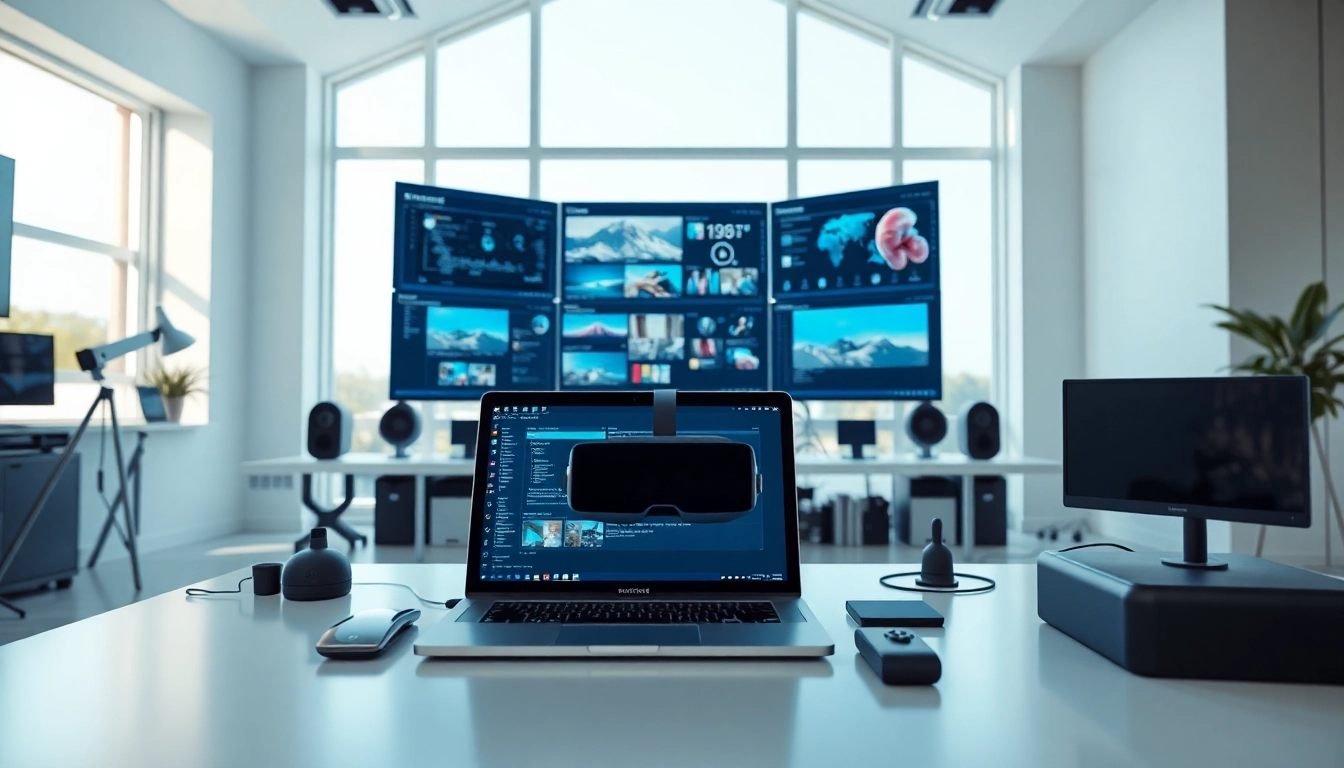Understanding Virtual Desktop Technology
What is a virtual desktop?
A virtual desktop is a computing environment that mimics a physical desktop by allowing users to access their desktop environment remotely through a client device. This technology provides users with a familiar workspace regardless of their geographical location, effectively bypassing the limitations of traditional desktops. A virtual desktop operates through virtualization software, which translates the commands from a user’s device to a remote server, allowing users to interact with applications and files as if they were working on their own machines.
Key components of a virtual desktop
The fundamental components of a virtual desktop infrastructure (VDI) include:
- Virtual Desktop Hypervisor: This software layer manages the creation and execution of multiple virtual desktops on a physical server.
- Client Devices: Users access virtual desktops via various devices such as laptops, tablets, and smartphones, enabling flexibility and mobility.
- Remote Connection Protocols: These protocols facilitate data transmission between client devices and servers. Examples include RDP (Remote Desktop Protocol) and ICA (Independent Computing Architecture).
- Storage Solutions: Virtual desktops often rely on centralized storage systems, which provide data access across different applications and users seamlessly.
- Management Tools: VDI solutions require management software to handle provisioning, monitoring, security, and updates.
How does virtual desktop work?
The underlying principle of a virtual desktop involves virtualization technologies that abstract physical hardware. The process begins with a hypervisor that creates multiple virtual machines (VMs) on a physical server. Each VM acts as a standalone environment with its own operating system and applications, which users log into remotely.
The server host, equipped with powerful hardware resources, manages these VMs and ensures they remain responsive and secure. When a user logs into their virtual desktop, the hypervisor allocates resources such as CPU, memory, and storage based on predefined policies. The user can interact with the virtual desktop seamlessly, and any actions taken—like opening applications or saving files—are processed on the server, not the local machine. This architecture allows users to work from virtually anywhere while securely accessing their desktop environments.
Benefits of Adopting Virtual Desktop Solutions
Cost efficiency of virtual desktop
One of the most significant advantages of virtual desktops is their cost efficiency. Organizations can reduce expenses related to hardware, software licensing, and maintenance. With a centralized IT environment, companies can extend the lifecycle of older devices by using them as thin clients to access virtual desktops. Furthermore, the reduced need for physical infrastructure simplifies IT management and minimizes energy costs.
Additionally, virtual desktops often come with pay-as-you-go pricing models, allowing businesses to scale resources according to their needs. This flexibility ensures that organizations only pay for what they use, making budgeting more predictable.
Enhanced security features of virtual desktop
Security is a paramount concern for businesses today. Virtual desktop solutions inherently provide robust security features that protect sensitive data. Since the data is stored centrally on servers rather than local devices, it is less vulnerable to theft or loss. Virtual desktops can also be configured with advanced security protocols like encryption and multi-factor authentication to enhance data protection.
Moreover, administrators have complete control over user access and permissions, allowing them to enforce security policies consistently across all devices. In the event of a data breach, organizations can quickly revoke access to compromised accounts without affecting the entire system.
User flexibility with virtual desktop
The flexibility offered by virtual desktops is unmatched. Users can access their virtual desktop environments from any device with an internet connection, whether it’s a laptop at home, a tablet in a coffee shop, or a smartphone while commuting. This accessibility encourages remote work, enabling employees to stay productive from anywhere in the world.
Furthermore, virtual desktops support various operating systems and applications, allowing users to transition seamlessly between different environments. This capability is especially beneficial for organizations with a diverse workforce requiring different software setups.
Common Applications of Virtual Desktop
Virtual desktop for remote work
As remote work becomes increasingly common, virtual desktops provide a practical and effective solution. Employees can access their work applications and files regardless of their location, ensuring continuity and productivity. The ability to use a familiar desktop environment helps minimize disruptions and enhances focus.
For organizations, adopting virtual desktops for remote work allows them to maintain a connected infrastructure without requiring extensive physical office space. This flexibility can lead to happier employees and potentially lower overhead costs.
Educational use of virtual desktop
The education sector has leveraged virtual desktops to create dynamic learning environments. Educational institutions can provide students and faculty with access to powerful computing resources and specialized software without the need for high-end individual devices. This democratization of access allows for innovative teaching methods, such as remote labs and collaborative project work.
Virtual desktops also offer students a consistent and secure online environment for studying, making it easier to manage assignments and group projects. As a result, educators can focus on enhancing the learning experience rather than troubleshooting technical issues.
Creative industries utilizing virtual desktop
Creative professionals in industries such as graphic design, video editing, and 3D modeling benefit from virtual desktops’ potential. High-resource applications can be run on powerful centralized servers, allowing designers and artists to work on complex projects without the constraints of local hardware limitations.
This setup promotes collaboration by letting teams work on shared projects in real-time, regardless of their physical locations. Moreover, virtual desktops can be easily reconfigured to meet specific project requirements, making them a versatile choice for creative teams.
Best Practices for Implementing Virtual Desktop
Choosing the right virtual desktop provider
Selecting a virtual desktop provider is crucial for successful implementation. Organizations should consider factors such as scalability, reliability, support, and user experience when evaluating providers. It is also essential to look for services that offer robust security measures and compliance standards.
Organizations should conduct thorough research, read reviews, and request trials or demos. This hands-on experience allows stakeholders to assess whether the solution aligns with their organizational needs and user expectations.
Optimal configurations for a virtual desktop
To maximize the benefits of a virtual desktop, proper configuration is essential. Organizations should determine the necessary resources based on user requirements and workload characteristics. Factors such as available bandwidth, storage capacities, and session management should be evaluated to ensure a seamless user experience.
Additionally, implementing tiered access levels based on user roles can enhance security and optimize resource allocation. Regularly updating and optimizing configurations helps minimize latency and interruptions, creating a more efficient working environment.
Troubleshooting common virtual desktop issues
Even with the best configurations, users may encounter issues with their virtual desktops. Common problems include connectivity issues, latency, and application performance problems. Organizations should have a robust troubleshooting protocol in place to address these challenges efficiently.
Regular training sessions can help empower users to solve minor issues themselves, fostering self-sufficiency. Furthermore, maintaining an open line of communication with the support team can expedite the resolution of more complex problems. Continuous monitoring of performance metrics will help anticipate potential issues before they impact users.
Measuring Success with Virtual Desktop Implementation
Key performance indicators for virtual desktop
Measuring the effectiveness of a virtual desktop implementation is vital for ongoing optimization. Key performance indicators (KPIs) include metrics such as resource utilization, uptime, and application response times. Monitoring these KPIs provides insights into how well the virtual desktop environment is functioning and where improvements are necessary.
Setting benchmarks based on historical data and desired outcomes can help stakeholders assess the impact of virtual desktop technology on productivity and overall performance. Regular evaluations allow organizations to make informed decisions regarding necessary configurations or enhancements.
User satisfaction metrics for virtual desktop
User satisfaction is a fundamental aspect of assessing the success of virtual desktop implementation. Organizations should gather feedback through surveys and user interviews to understand their experiences with the virtual desktop environment.
Common factors impacting user satisfaction include system performance, accessibility, and support responsiveness. By actively listening to users’ concerns and suggestions, organizations can make targeted improvements that enhance the overall virtual desktop experience.
Future trends in virtual desktop technology
As technology continues to evolve, several trends are shaping the future of virtual desktops. One notable trend is the increased use of artificial intelligence (AI) and machine learning to enhance user experiences and optimize resource allocation. These technologies can predict usage patterns and adjust resources dynamically, ensuring users always have access to the tools they need.
Additionally, the rise of hybrid work environments is pushing organizations to invest in more flexible and secure virtual desktops that support both remote and on-site operations. The integration of advanced security features, such as biometric authentication and enhanced multi-factor authentication, will provide better protection for sensitive data in this evolving landscape.
In summary, virtual desktop technology continues to advance, providing organizations with innovative solutions that meet the demands of a changing workforce. With careful implementation and ongoing evaluation, businesses can unlock the full potential of virtual desktop solutions, empowering their employees to work efficiently and securely from anywhere.



